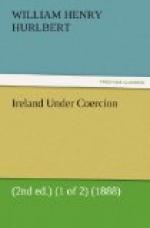To get an actual touch and living sense of the social conditions amid and against which they are working in Ireland was my object, I repeat, in making the visits, of which this book is a record. More than this I could not hope, in the time at my disposal, to do. With very much less than this, it appears to me, many persons, whose views of Irish affairs I had been inclined, before making these visits, to regard with respect, must have found it possible to rest content.
CHAPTER I.
Dublin, Monday, Jan. 30, 1888.—I left London last night. The train was full of people going to attend levees and drawing-rooms about to be held at Dublin Castle.
Near Watford we lost half an hour by the breaking of a connecting-rod: but the London and North-Western is a model railway, and we ran alongside the pier at Holyhead exactly “on time.” There is no such railway travelling in America, excepting on the Pennsylvania Central; and the North-Western sleeping-carriages, if less monumental and elaborate than ours, are better ventilated, and certainly not less comfortable.
I had expected to come upon unusual things and people in Ireland, but I had not expected to travel thither in company with an Irish Jacobite. Two of my fellow-passengers, chatting as they smoked their cigarettes in the little vestibule between the cabins of the carriage, had much to say about Lord Ashburnham, and the “Order of the White Rose,” and the Grand Mass to be celebrated to-morrow morning at the Church of the Carmelites in London, in memory of Charles Edward Stuart, who died at Rome in 1788, and now lies buried as Charles III., King of Great Britain and Ireland, in the vaults of the Vatican, together with his father “James III.,” and his brother “Henry IX.” One of the two was as hot and earnest about the “Divine Right of Kings” as the parson who, less than forty years ago, preached a sermon to prove that the great cholera visitation of 1849 was a direct chastisement of the impiety of the Royal Mint in dropping the letters D.G. from the first florins of Queen Victoria issued in that year. He bewailed his sad fate in being called over to Ireland by family affairs at such a moment, and evidently did not know that the Mass in question had been countermanded by the Cardinal Archbishop.
The incident, odd enough in itself, interested me the more that yesterday, as it happens, the Cardinal had spoken with me of this curious affair.
He heard of it for the first time on Saturday, and, sending at once for the priest in charge of the Carmelite Church, forbade the celebration. Later on in the evening, two strangers came to the Archbishop’s house, and in great agitation besought him to allow the arrangements for the Mass to go on. He declined to do this, and sent them away impaled on a dilemma. “What you propose,” said the Cardinal, “is either a piece of theatrical tomfoolery, in which case it is unfit to be performed in a church, or it is flat treason, in which case you should be sent to the Tower!”




